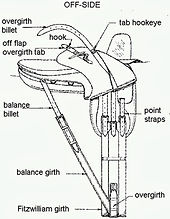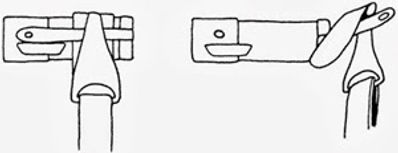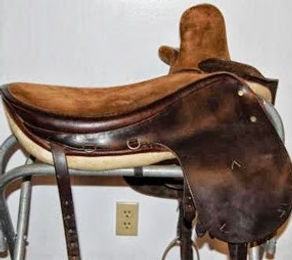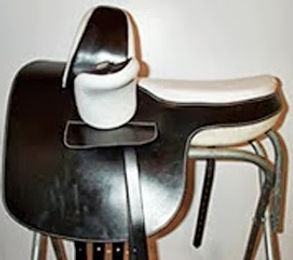
General Information about Side Saddles
A very common question is, “What is the best brand of saddle?” The answer is simple – one that fits you and your horse. As with astride saddles, many aside riders have a favorite brand or feature they swear by. Some like Owen's board-flat seat, others prefer the slight dip commonly found in Mayhews. Some would never ride with narrow pommels, while others hate wide ones. The best way to find out what saddles you like is to try a lot of saddles. Attend clinics or visit friends and ask to sit in their saddles – most folks are happy to let you try! And remember, the most important thing is to fit your horse first – if he is not comfortable, you never will be.
You will hear the term “old name” saddles (or ONES – old name English saddles) when aside riders talk about saddles. The most well-known quality side saddle makers were active from around 1890-1940, hence “old name.” These companies included Whippy, Mayhew, Champion & Wilton, Owen, and Martin & Martin. At the time these saddles were made, they were top-quality, and many are still in use today. Other high-quality but lesser-known names include Cross, Knoud, Robson, Bunney, Gidden, Wilkenson & Kidd, Turk, Barnsby, Hermes (yes, they made a few side saddles!) and countless others. Vintage western saddles also have famous makers, including S.C. Gallup and R.T. Frazier. Sears and Montgomery Wards even made very good saddles, though not to the exceptionally high quality of the makers named above. There are also many high-quality saddles – English and Western - with no maker's mark at all.
Maker's marks can usually be found near the stirrup bar, either stamped into the leather or a metal plate attached to the point. Some makers used marked nailheads, or stamped the fixed head. Some makers had labels on the offside point or on the tree, hidden by the panels. Some trees have labels stating the person who ordered it, and the year it was made. Trees may be made by one company, and the saddle built by another. Any and all of these marks can be damaged, obscured, replaced, or lost over time, so it can sometimes be very difficult to say who made a saddle! In addition to maker's marks, saddles are identified as a “type” based on pommel shape, seat shape, type of stirrup fitting, stirrup flap, and other details. However, none of these details can offer a positive identification - only the maker marks can do that.
Most side saddles are built to be ridden on the nearside – with the rider's legs on the left. Some saddles were built for offside use, and a few are reversible. Offside saddles may be helpful for riders with certain disabilities, such as extreme difficulty bending the right hip or knee, or amputation. Some historic riding manuals also suggested riding offside on occasion to help keep the body balanced. Reversible saddles largely appear to be made for very small riders, perhaps even children, and have a more symmetrical shape than the more usual side saddle. A few side saddles were also made for men, generally with war injuries. Read more about side saddles for men.
Typical modern english side saddles have an asymmetrical tree with the offside point being only slightly longer than in an astride saddle, but the nearside point extends much further down the horse's side. This long point makes fitting the English saddle a potentially tricky art, but it also provides much of the saddle's stability. Wool-flocked panels pad the horse's back from the wood and metal tree.

English Saddles



Most vintage English side saddles were built for hunt use, or as it is commonly phrased, “reinforced for jumping.” This reinforcement is a thick steel bar across the fork (front) of the saddle. This bar is in addition to the metal frame used to reinforce the entire tree across the points. Often about .25” thick, it can be felt through the thin leather lining, or should be visible if the lining is missing or deteriorated. X-raying the saddle is not necessary to determine the bar's presence. Saddles missing the bar typically have very thin panels and are known as “park” saddles.
Correct billet placement is normally forward, just behind the points of the tree. Billets placed too far back tend to push the saddle forward. Side saddles usually have three billets on each side, though there may be only two. In addition, a point billet is usually found on the near side, and is used to connect the balance girth. Point billets are occasionally found on the off side and may be used to help stabilize the saddle if it moves forward when using the other billets.



Whippy
Whippy (formally, Whippy Steggall) saddles came with a variety of styles of stirrup fittings, though a Mayhew type may be the most common. One distinctive Whippy detail is the nailhead in the skirt near the cantle on both the near and off sides. Whippy was purchased by Champion & Wilton in 1940
Martin & Martin



Martin & Martin saddles were built in the US and England. Most M&M saddles have a hinged spring arm on the offside flap. It eliminates the need for an overgirth, and also holds the flap up while tightening the girth whether from the ground or the saddle. Some other saddlers later made use of this spring arm as well. M&M used three different stirrup fittings, the earliest being a simple roller bar. The company also used a fitting that was fixed on the nearside, ran the leather through a metal channel across the gullet, and adjusted from the offside. The final fitting, a breakaway safety fitting, is known as a “bullseye” due to the hole in the part that attaches to the stirrup leather.
Champion & Wilton



Champion & Wilton saddles are distinguished by the stirrup flap. Unlike other makes, it extends onto the safe. Underneath, the arm of the stirrup fitting is secured into the flap, ensuring the fitting will open if the flap rises (ie – the rider's legs are not holding it down). Riders could order an optional blocked head, which gives added surface area to grip against while jumping, but it is uncommon and typically found in saddles built from 1900 to 1910. Other makers – some good, some bad - have copied the flap, fitting, and blocked head. Genuine C&W parts are stamped as such.
Mayhew



Mayhew held the original patent for its popular wide triangular pommels, dated 1891. It was also known for a simple breakaway stirrup mechanism, which later was used on Whippy, C&W, and other saddles. Many Mayhews are stamped “Lissadell”, a hunting model. Mrs. Doreen Archer Houblon patented a unique leaping head in 1936, and Mayhew was the sole maker of these unusual pommels designed for an extreme forward seat over fences. Mayhew closed its doors shortly after WWII, and Champion & Wilton acquired its assets.
Owen



Owens are known for their very flat seats (some even flatter than the one shown here) and their unique “teardrop” stirrup flap. The flap covers a male/female safety stirrup mechanism, also unique to Owen. It is not necessary to have the same serial number on both halves of the stirrup fitting, though a replacement fitting may need a little filing to fit the wear pattern on the saddle half. For some reason, Owens often measure a little shorter than they ride, that is, a 21” saddle may fit a 22” rider quite well. Only sitting in it will tell for certain!
Eldonian


Eldonian saddles were built in England in the 1970s on vintage trees. The style and features of the saddle will vary based on the tree that was used. However, the quality of the work is good.
Steele Equitation


This modern English style saddle is made on bars similar to a western saddle rather than the points and flocked panels of a typical English saddle. The bars allow a fit to a wider variety of horses, but does not offer the reinforcement in the gullet of the tree or the padding forjumping. These saddles are currently being built on custom order by The Side Saddlery.
Elan


These Asian made saddles are modern versions of the English side saddle. They can be a good entry level saddle for a rider who is experimenting with side saddle for the first time. While not the same quality as an “old name” saddle, they are certainly rideable. The same cannot be said of all Asian-made saddles.
Wykham Pad


This Champion & Wilton was retro-fitted onto a Wykham pad in the 1920s. The pad replaces the panels, and different pads could be used to fit the same saddle to different horses. Note the pockets for the tree points, and the leather COVERED tab at the cantle to buckle it on.
Western Saddles


Western saddles are built on bars, much like their astride western counterparts. The bars are generally lined with fleece, though vintage saddles may have thin panels and modern ones may have memory foam. The seat may be “bowl-shaped” to cradle the rider. This cradling effect makes it all the more important to have a saddle the right size for the rider, but also often more difficult to take an exact seat measurement. Test-sitting is important before dismissing a saddle as “the wrong size.” Western side saddles can be plain or heavily ornamented with silver, stamping, or carving and have varying skirt shapes to suit different horse builds.Western saddles are not suitable for jumping, but are used for cutting, penning trails, pleasure, barrels, and other activities where you might see a western astride saddle. In the early 1900s, the Visalia company even made a side saddle for roping!

The most stable rigging is similar to double rigging. The front cinch is attached as normal. The rear cinch attaches as normal on the offside, but is fastened below the front cinch on the nearside. This arrangement allows the rear cinch to act similar to an English balance girth without altering a historic saddle and has proven more stable than the usual double rigging arrangement. Some western saddles do provide for an actual balance girth. Those saddles with center-fire girths will become more stable if converted to double rigging or a balance girth.
Steele Western Pleasure


A modern western side saddle, built on a Steele tree by The Side Saddlery [link to The Side Saddlery]. “Steele” refers to the tree, not the maker of the saddle. The leaping head position, bolted to the fixed pommel, is unique to Steele. The bolt is recessed so as not to interfere with the rider's leg. The fixed pommel is adjustable on some saddles, to make the seat longer or shorter. The Side Saddlery offers a standard leaping head as a custom modification to the tree. Other options include detachable saddle bags and memory foam seat.
Goodnight


Charles Goodnight (of the Goodnight-Loving Trail fame) developed this sturdy saddle type for his wife so she could accompany him on cattle drives. The heavy leather and the skirting and rigging styles make this a durable, hardworking saddle. This example has an offside grab handle near the right knee. This offers extra security when the horse cuts cattle. The style was built by a number of saddlers, including Frazier and Gallup (the originator). Read more about the history of these saddles.
Goodnight Style Offside


This saddle is a recently restored Goodnight style western offside saddle. The tree is rawhide covered. It has full double rigging and the rigging rings are leather covered to prevent the iron from causing deterioration in the skirt. The seat and pommels were re-covered in deerskin, true to the original saddle, and they will darken with wear to the more common tan color. The square skirts have typical border tooling as well as fan-like tooling in the corners that help date it to the mid-1890s. The restoration was done by The Side Saddlery.
Antique Catalog Saddle



The antique catalog saddles were mass produced for the evolving middle class in America – people with money to spend on a special saddle for the ladies of the house but no need or desire to import expensive saddles from England. The saddles were ordered from catalogs such as Sears, Montgomery Wards and many now-forgotten names or even purchased at local hardware stores. Some were very fancy, with decorative stamping painting and stitching, while others lacked a leaping head, which was an extra expense.
Antique Hoop Saddle

The hoop or siderail was an added safety feature on saddles from the Appalachian region in the US, and were also seen in Mexico and South America. Saddles from "South of the Border" often have designs embroidered using cactus spine. In some cases, the rail could be buckled into place, and some had fringe or decorative leatherwork.
Also See:


